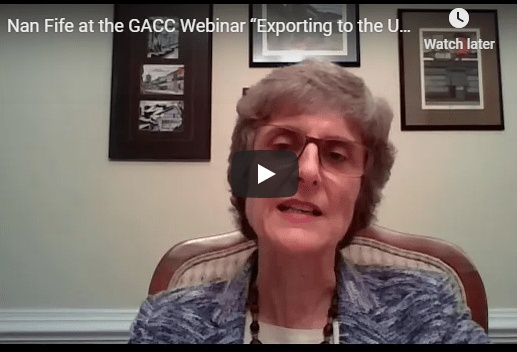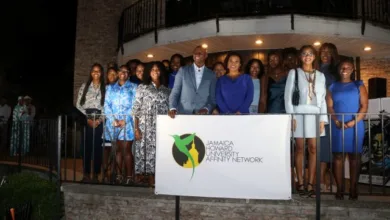Initiatives Identified To Assist Guyana In Accessing the U.S. Market


Washington, DC– A number of follow up initiatives is to be undertaken resulting from the virtual conference held last Thursday (Oct. 28th) to address strategies for accessing the United States market for good and services from Guyana.
These initiatives include:
- an undertaking from the US Department of State to facilitate discussions with the United States Trade Representative’s Office (USTR) for an increased quota for Guyana sugar on the US market;
- an intensification of the lobby on the part of Guyana and other CARICOM rum producing countries to expand market share;
- efforts by local private sector bodies to seek to encourage syndicated production for export by small and medium sized producers so as to meet the demand for quality, quantity and reliability of supply;
- the establishment of an electronic platform that will provide Guyanese exporters with updated information on standards and regulations as well as promotional activities about accessing the US market for products and services including those of the creative industries.
Last Thursday’s conference, put on by the U.S. based Guyanese American Chamber of Commerce (GACC), brought together representatives of US and Guyana government and private sectors in an examination of the barriers to increased Guyana exports to the US and identification of workable solutions for easier access for Guyanese exports to the American market.
“The United States wants to remain Guyana’s number-one trade partner, and American businesses want to expand their operations in Guyana. One key element in the decision process of U.S. firms is to know that regulations and laws are fair and clear so there will be a level playing field. Transparency and reliable regulations will help enable continued growth when the pandemic finally ebbs. As Guyana’s economy grows and U.S. investors are attracted to Guyana, opportunities for Guyanese firms will also grow,” Nan Fife, Director of the Office of Caribbean Affairs, US State Department said in declaring the conference open.
Click image to watch Nan Fife’s Opening Remarks
She referred to a number of agreements in place to facilitate Guyana/U.S. trade and business development including a Memorandum of Understanding signed recently between the two countries during the visit of US Secretary of State Mike Pompeo.
“There is a reason that I have spent this much time reviewing for you today the principles of the Growth in the Americas Memorandum of Understanding. It aligns almost perfectly with many points in the Guyanese American Chamber of Commerce Mission Statement. For example, the first point in the mission statement is to generate “new business and market access for our members,” which is also the driver behind the Memorandum of Understanding. The Chamber of Commerce calls for favorable policies and legislation, just as the Memorandum of Understanding does. The Chamber has a call to share information and knowledge in a timely manner, and the Memorandum of Understanding calls for information sharing. We can go through it point-by-point, but I think we all understand that as traders and investors, all sides are looking for fair, transparent, and reliable regulations and opportunities. In short, the Growth in the Americas initiative and the Guyanese American Chamber of Commerce are already aligned.
Along with the Growth in the Americas Memorandum of Understanding, we have committed through the U.S. Agency for International Development to support locally led development activities through programs focused on good governance.
“The goal is to improve citizens’ involvement in the economic development process. Importantly, this will focus on transparent use of resources and accountability by those involved,” she concluded.
Speaking on behalf of the Guyana government, Dr. Dianne Glasgow, Director of Foreign Trade in the Ministry of Foreign Affairs and International Cooperation pointed to a number of constraints that impact access to the US market for Guyanese exporters.
“These preferential schemes are key to the price competitiveness of Guyanese exports to the United States given Guyana lack of economies of scale in production, concomitant on its small market size.
“Notwithstanding secured access through trade agreements our export basket to the US, as with most other countries we export to, remains narrow.
“A myriad of factors account for this, including limited productive capacity domestically and challenges to expanding business activities. Among the mix are challenges related to information asymmetry including on how to make initial access to an export market, what are the tariffs and duties in place, what are the standards for compliance. For this reason, this conference today is extremely important to help to begin to fill a gap that limits deeper insertion into export markets and I trust that it is able to reach a wide range of budding exporters as well as existing exporters who may be interested in expanding their reach across multiple States.
“With significant strides towards multilateral and regional liberalization, tariffs have become less of a hurdle to international trade. The mismatch between trade flows and trade policy attests to the limited impact of tariff liberalization. What is far more important to global trade, particularly trade in agricultural products, which is in line with Guyana’s natural comparative advantage, is standards and technical regulations. These account for approximately 25% of barriers to trade in food and agricultural products. They have posed important market access challenges for Guyana, including with exports to the United States, as the issue with Catfish exports and earlier concerns with Turtle Excluder Devices, reaffirm.
“In building awareness of the import requirements of the U.S. for standards and regulations, this Conference is supporting what researchers at the World Bank advocate for, that is, proactive compliance as a strategic approach to reducing the significance of standards and regulations as barriers to trade.
As a trade policy maker, this helps because ultimately, we want to be able to match policy outputs (vis-à-vis trade agreements) with outcomes, through increased trade flows. Presently what obtains is a huge disparity between trade policy and trade flows. A stronger role for the private sector will help realign the trade policy with trade flows so that there is more trade under the agreements by addressing the wide gamut of market access challenges, Dr. Glasgow told the meeting.
GACC President Wesley Kirton said the chamber will be following up on a number of other recommendations arising out of the presentations by the US Department of Agriculture (USDA), the US Food & Drug Administration (FDA) and the US Customs and Border Protection (CBP).






